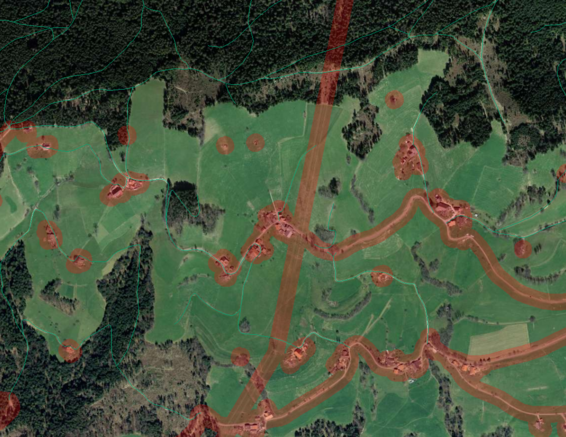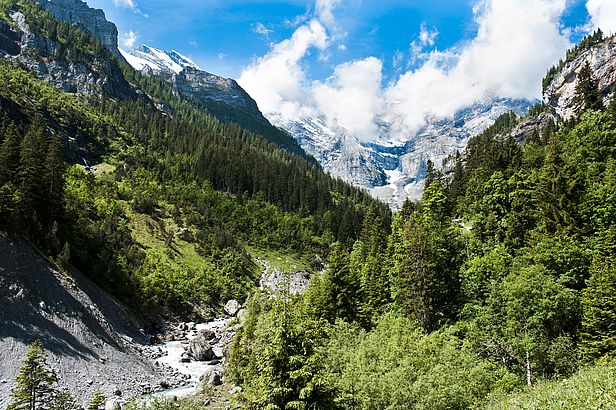7.3.2019 | Beate Kittl | News WSL
A third of Swiss landscapes are still largely undeveloped and near-natural, shows a report from the Swiss Federal Institute for Forest, Snow and Landscape Research (WSL). Such open spaces are mainly located in steep rocky and glacial areas in high alpine regions. The authors argue that more consistently enforced spatial planning is required to ensure their protection and sustainable use.
Untouched areas with no infrastructure, such as roads, houses or ski lifts, are as popular as they are rare in Switzerland. They attract crowds of people wishing to engage in recreational activities, and adorn holiday resort brochures. However, they are spread very unevenly across Switzerland since the country continues to develop inexorably. Two WSL landscape researchers have now ascertained how many largely untouched areas there are and how spatial planning measures could safeguard them in the long term.

After all, such open spaces not only fulfil vital ecological functions, but also have considerable material and immaterial value, whether for Switzerland's attractiveness for tourists and companies, or for the quality of life and recreation of local residents. Switzerland is faced with the dual challenge of protecting the valuable natural landscape and cultural heritage, and promoting tourism, energy generation and other economic developments.
For their study, Gero Nischik and Marco Pütz categorised infrastructure such as transport routes, buildings, sports facilities, aerial cableways and power plants as 'disruptive' or 'non-disruptive', based on the results of a previous public survey. Using a geographic information system (GIS), they recorded and calculated the spatial distribution and the extent of 'disruptive' infrastructure depending on the level of disruption for the landscape. They defined 'near-natural open spaces' as landscapes where such 'disruptive' infrastructure encroaches on less than 20% of the surface area. Such spaces can be used simultaneously for nature-based recreation, and sustainable forestry, hunting and farming. By making this distinction, the authors took into account that aspects relating to conservation and use are treated as roughly equivalent in spatial planning. They displayed the results on a map of Switzerland.
Based on these criteria, they identified nearly 2,400 areas – a third of all Swiss landscapes in total – that were differentiated by hydrological modelling. Around half of these areas are already protected at national and cantonal level, whether through parks or federal inventories. The cantons with the highest proportions of near-natural areas are Grisons, Uri, Glarus and Valais.
Untouched areas almost exclusive to mountains
However, the vast majority of near-natural open spaces are found on steep and barren rocky and icy surfaces at altitudes of more than 2,000 m, where development is difficult and expensive. At 0.2%, the proportion of near-natural open spaces at altitudes below 500 m is vanishingly small.
The 50% of open spaces that do not lie in conservation areas face the threat of being further built up with recreational, hydropower or other facilities. "It is still important to safeguard remaining open spaces through spatial planning measures," the authors write. After all, they state, usable space is limited, and the landscape is of great importance to people and Switzerland.
They conclude that there is a good legal basis for this in the form of the revised Swiss Spatial Planning Act. "A lack of enforcement and poor implementation are hindering the effective conservation of areas," says Gero Nischik. The authors believe that, to resolve this issue, local residents and, above all, politicians must develop greater awareness of the value of unspoilt areas for recreational and leisure activities, nature-based tourism and sustainable agriculture. They further argue that, as well as providing the competent spatial planning authorities with sufficient resources, offering economic incentives or encouraging the dismantling of roads and other structures to create near-natural sites can enhance the conservation of open spaces. They also propose limit values for land use ('land-use certificates') that would work in a similar way to air pollution control values.
Time is running out. "Switzerland's continuing development necessitates the swift, consistent conservation of near-natural open spaces," says Nischik. Otherwise, the authors argue, more and more open spaces that have so far hardly been touched by roads, railways or tourist transport facilities will turn into purely residential, economic and transport areas at the expense of the landscape and ecology.
Further links: ¶
Contact ¶
Copyright ¶
WSL and SLF provide image and sound material free of charge for use in the context of press contributions in connection with this media release. The transfer of this material to image, sound and/or video databases and the sale of the material by third parties are not permitted.


